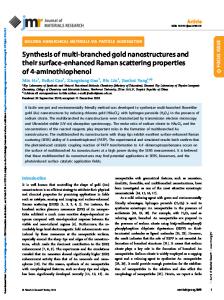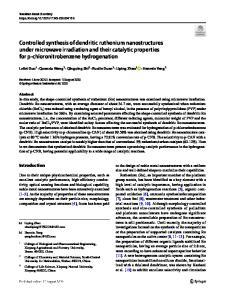Green synthesis of Cu/Cu 2 O/CuO nanostructures and the analysis of their electrochemical properties
- PDF / 3,256,226 Bytes
- 15 Pages / 595.276 x 790.866 pts Page_size
- 77 Downloads / 342 Views
Green synthesis of Cu/Cu2O/CuO nanostructures and the analysis of their electrochemical properties Xolile Fuku1 · Mmalewane Modibedi1 · Mkhulu Mathe1 Received: 30 December 2019 / Accepted: 6 April 2020 © Springer Nature Switzerland AG 2020
Abstract Heterogeneous Cu/Cu2O/CuO nanoparticles were synthesised via polyphenols of pomegranate for various application. X-ray diffraction and high resolution-scanning electron microscopy confirmed Cu/Cu2O/CuO NPs crystallinity and the particle size which ranged from 5 to 20 nm. The electrochemical band gap energies of Cu/Cu2O/CuO NPs were calculated to be between 0.9 and 2.1 eV. EIS measurements were used to calculate the capacitance and specific capacitance of the nanoparticles which were found to be 11.2 F and 69 F g−1. Surface diffusion coefficient obtained from cyclic voltammetry was found to be 1.54 × 10−6 cm2 s −1 with r2 of 0.99 suggesting a fast electron movement. The calculated surface coverage was 1.38 × 10−3 mol cm−2 suggesting the formation of monolayer at the electrode interface. The results confirmed the electroactivity of Cu/Cu2O/CuO electrode towards the volatile organic compound- ethanol. Cu/Cu2O/CuO exhibited good electrochemical performance towards ethanol with higher current density and most negative onset potential − 0.3 V, meaning that it requires lower energy for ethanol activity to occur at the electrode interface. EIS profiles confirmed the kinetics of Cu/Cu2O/CuO at the electrode surface with characteristic small circular curvature signifying that the polarisation resistance (Rp) is prominent, proposing a faster electron shuttling process for ethanol activity. Further, the amperometric response with long time test for the Cu/Cu2O/CuO based electrode system estimated a lower limit of detection to be 0.09 µM at a signal to noise ratio of 3 with sensitivity of 0.049 µA µM−1 at steady state. Raman and FTIR highlighted mechanism of coordination. Keywords Cu/Cu2O/CuO nanoparticles · Pomegranate · Electrochemical methods · Ethanol activity · Capacitance · Mechanism
1 Introduction Of late, Green synthesis has become a centre of attention in different disciplines of nanotechnology. The term ‘Green chemistry’ was invented by the US Environmental Protection Agency (EPA-1990s) with the aim to stimulate cutting-edge eco-friendly technologies in the production, design and use of chemical products [1–3]. In the last decade, Green Chemistry was used to achieve sustainability since it was adopted as a culture and a methodology. Current developments in nanotechnology, particularly the
capability to synthesise highly methodical nanomaterials of any shape and size, have led to the production of innovative materials. The characters of metal and metal oxide nanomaterials have been of great interest due to their distinctive feature such as catalytic activity, optical, magnetic and electrical properties [4–9]. Nanoparticles coordination with biological entities (e.g., microorganisms) has created a succession of nanoparticle-biological interfaces that depend on both col
Data Loading...











